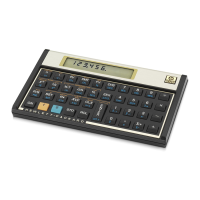18 Section 1: Getting Started
Keying in Large Numbers
Since the display cannot show more than 10 digits of a number, numbers greater
than 9,999,999,999 cannot be entered into the display by keying in all the digits
in the number. However, such numbers can be easily entered into the display if
the number is expressed in a mathematical shorthand called “scientific notation.”
To convert a number into scientific notation, move the decimal point until there
is only one digit (a nonzero digit) to its left. The resulting number is called the
“mantissa” of the original number, and the number of decimal places you moved
the decimal point is called the “exponent” of the original number. If you moved
the decimal point to the left, the exponent is positive; if you moved the decimal
point to the right (this would occur for numbers less than one), the exponent is
negative. To key the number into the display, simply key in the mantissa, press
Æ (enter exponent), then key in the exponent. If the exponent is negative,
press Þ after pressing Æ.
For example, to key in $1,781,400,000,000, we move the decimal point 12
places to the left, giving a mantissa of 1.7814 and an exponent of 12:
Numbers entered in scientific notation can be used in calculations just like any
other number.
The CLEAR Keys
Clearing a register or the display replaces the number in it with zero. Clearing
program memory replaces the instructions there with gi000. There are
several clearing operations on the HP 12C Platinum, as shown in the table
below:
Keystrokes Display
1.7814Æ12
1.7814 12
1,781,400,000,000 entered in
scientific notation.
Key(s) Clears:
O Display and X-register.
fCLEAR² Statistics registers (R
1
through R
6
), stack
registers, and display.
fCLEARÎ Program memory (only when pressed in
Program mode).
fCLEARG Financial registers.
fCLEARH Data storage registers, financial registers,
stack and LAST X registers, and display.

